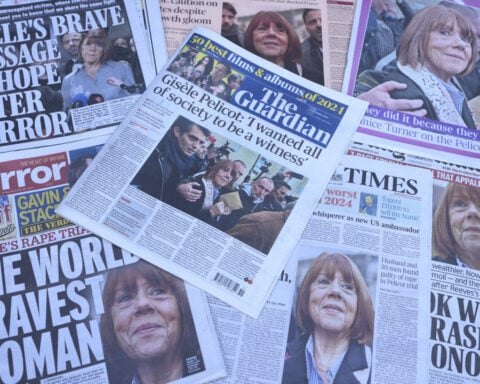When Kate Winslet stumbled upon the extraordinary story of Lee Miller she didn’t want to let go.
Miller was an American photographer who became a correspondent for British Vogue during World War II, shooting everything from London after the Blitz to the liberation of Dachau. In 1945, David E. Scherman took a rather famous photo of her in Hitler’s bathtub in Munich.
Before the war, Miller had already led many lives as a model and so-called “muse” to surrealists like Man-Ray. After, she continued documenting the fallout in Eastern Europe, all the while struggling with alcoholism, PTSD and trauma from sexual assault at a young age.
Winslet didn’t just want to play this woman; she wanted to shepherd the story to fruition. It set her on a nearly 10-year journey to bring “Lee” to the big screen. It opens nationwide Friday.
The Oscar-winning actor spoke to The Associated Press about the film, its impact and the toughest day she’s ever experienced as an actor. Remarks have been edited for clarity and brevity.
WINSLET: Many people are asking me, understandably, why Lee Miller? Why now? It’s evident, not least because of how important her work was, but because of what she represented in terms of what it means to be female. She was redefining femininity already 80 years ago to mean everything that it means to us now: Resilience and compassion and determination and togetherness and empathy and strength. She was not some up-and-coming little hotshot who was trying to make a name for herself. This was a middle-aged woman who had already lived so much life at the point that she went to Europe. She knew what was at stake. She knew that she was going to put herself in danger. She knew it was a huge risk, but she did it because she felt a compulsion to be that visual voice for the victims of conflict.
WINSLET: When I go to work, it’s never from a distance. The idea of protecting oneself or chilling out at the end of the day with a nice hot bath and a glass of wine, I just haven’t learned that. And I don’t know that I want to. I don’t think that’s how I work. I started this process in 2015, I went and sat with (Miller's son) Antony Penrose and (learned about) his time getting to know his mother only after she had passed away. It completely floored me. Not only did he get to know who she truly was and what she had done during the war, but he came to form a different level of understanding about why she had been the way she had been as a mother. As soon as I went to meet Antony, something happened to me. Something that goes beyond acting.
WINSLET: She might have been the first female cinematographer I’d worked with at that point. But in those days there weren’t very many women on sets. There were almost never women in the camera department. Ellen and I were kind of thrown together because we were on a very male-dominated set — happy to be there — but two of very few women. And whilst it was a great adventure, it was a really tough shoot. We always had to do so much in one day and it happened to be a brutal New York winter. We stayed friends and we worked together again on “A Little Chaos” (Winslet suggested her to Alan Rickman). I just thought to myself, why isn’t she doing features? It made sense on so many levels. This was somebody who had spent decades of her life being a visual eye, conveying narratives in a very powerful visual way. And that’s exactly what Lee Miller did. It wouldn’t have sat well with me if it had been a man. I almost feel like Lee would have been shaking her fists at me from her grave.
WINSLET: We made the film because I wanted for people to discover Lee Miller as this Lee Miller, the real Lee Miller on her terms in her most defining decade, not as the ex-lover and former muse of Man-Ray, these sort of reductive, sexist terms.
Her injustice streak was so powerful in her. And because she never told anyone what happened to her as a child, it drove her and it gave her a way of seeing the world. Women who were the survivors of sexual abuse who I spoke to in my preparation process, the two things they said in common was that they’d never told and that it gave them the ability to see evil at a mile. Lee had that. She had this somewhat innate capacity to tolerate hell.
In the scene when she reveals to (Vogue editor) Audrey (Withers) what happened to her when she was 7, Andrea (Riseborough, who plays Withers) and I said at the end of that filming day that it was inarguably the toughest day of filming that we’d ever done in our lives as actors ever. Just that one day. It sounds a bit extreme. I sort of shy away from talking about an actor’s process because at the end of the day, it’s not rocket science. We’re not curing cancer. We’re not on the front line ourselves. But sometimes you do find yourself going there to the extent that you feel a little bit possessed. And it can be a bit frightening.
What has taken my breath away is how women, complete strangers, come up to me and grab me by the arm and pull me close and say, “That was me. I was told to never tell.” That’s when filmmaking really can be extraordinary is if, just for a split second, you’re able to make an audience member feel held or seen.

 How to save a fentanyl victim: Key facts about naloxone
How to save a fentanyl victim: Key facts about naloxone
 Eight convicted in France over murder of teacher who showed Prophet caricature
Eight convicted in France over murder of teacher who showed Prophet caricature
 Death toll from German Christmas market car-ramming rises to four, Bild reports
Death toll from German Christmas market car-ramming rises to four, Bild reports
 France's Mayotte struggles to recover as cyclone overwhelms hospitals
France's Mayotte struggles to recover as cyclone overwhelms hospitals
 Russia's UK embassy denounces G7 loans to Ukraine as 'fraudulent scheme'
Russia's UK embassy denounces G7 loans to Ukraine as 'fraudulent scheme'
 Pope calls Gaza airstrikes 'cruelty' after Israeli minister's criticism
Pope calls Gaza airstrikes 'cruelty' after Israeli minister's criticism
 Retailer Party City files for bankruptcy, will wind down 700 stores
Retailer Party City files for bankruptcy, will wind down 700 stores
 Soccer's top players have had enough, as FIFA's new super-sized tournament sparks a revolt
Soccer's top players have had enough, as FIFA's new super-sized tournament sparks a revolt
 Lindsey Vonn finishes 14th in a super-G to mark her return to World Cup skiing at age 40
Lindsey Vonn finishes 14th in a super-G to mark her return to World Cup skiing at age 40
 Santa and Mrs. Claus use military transports to bring Christmas to an Alaska Native village
Santa and Mrs. Claus use military transports to bring Christmas to an Alaska Native village








